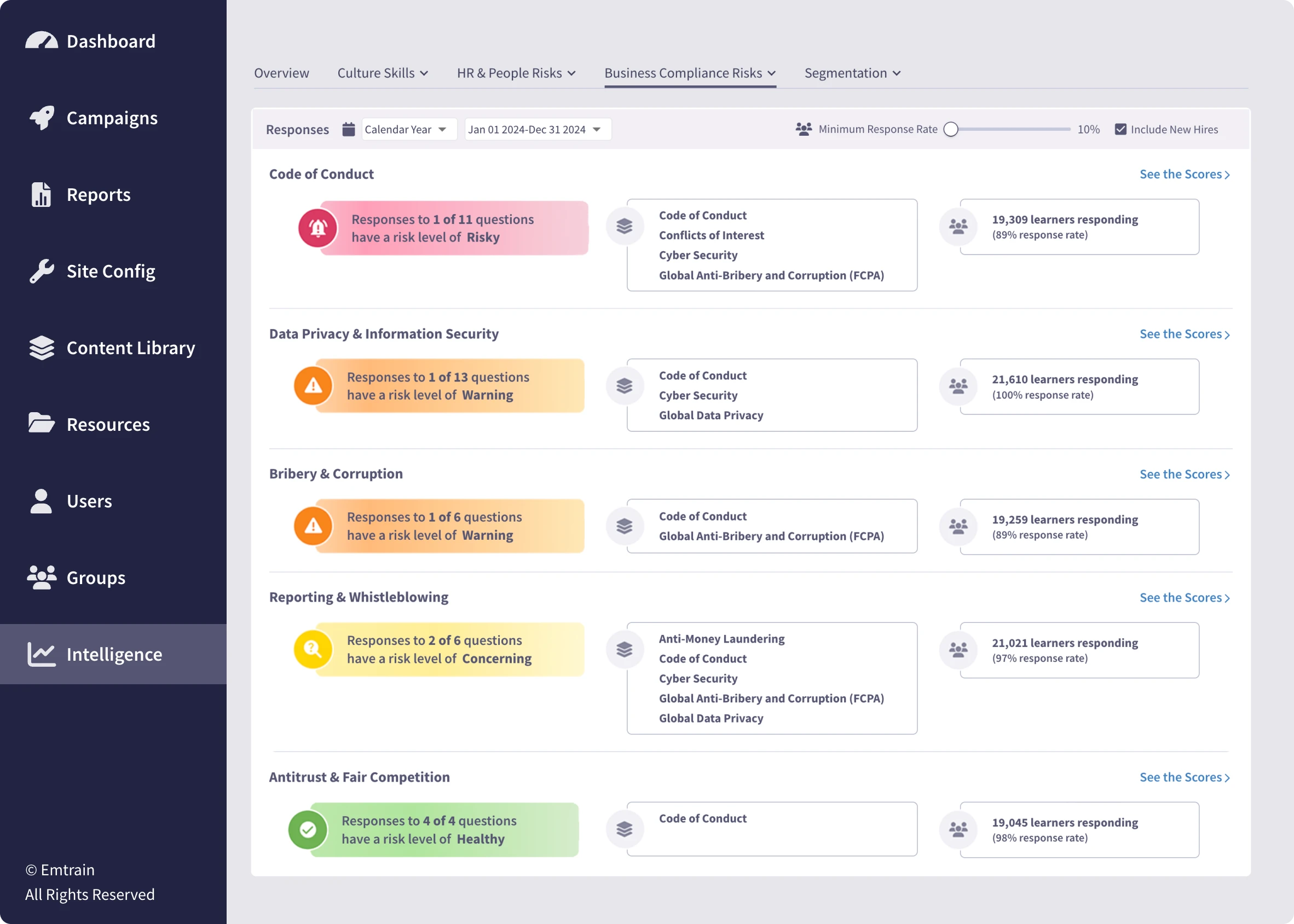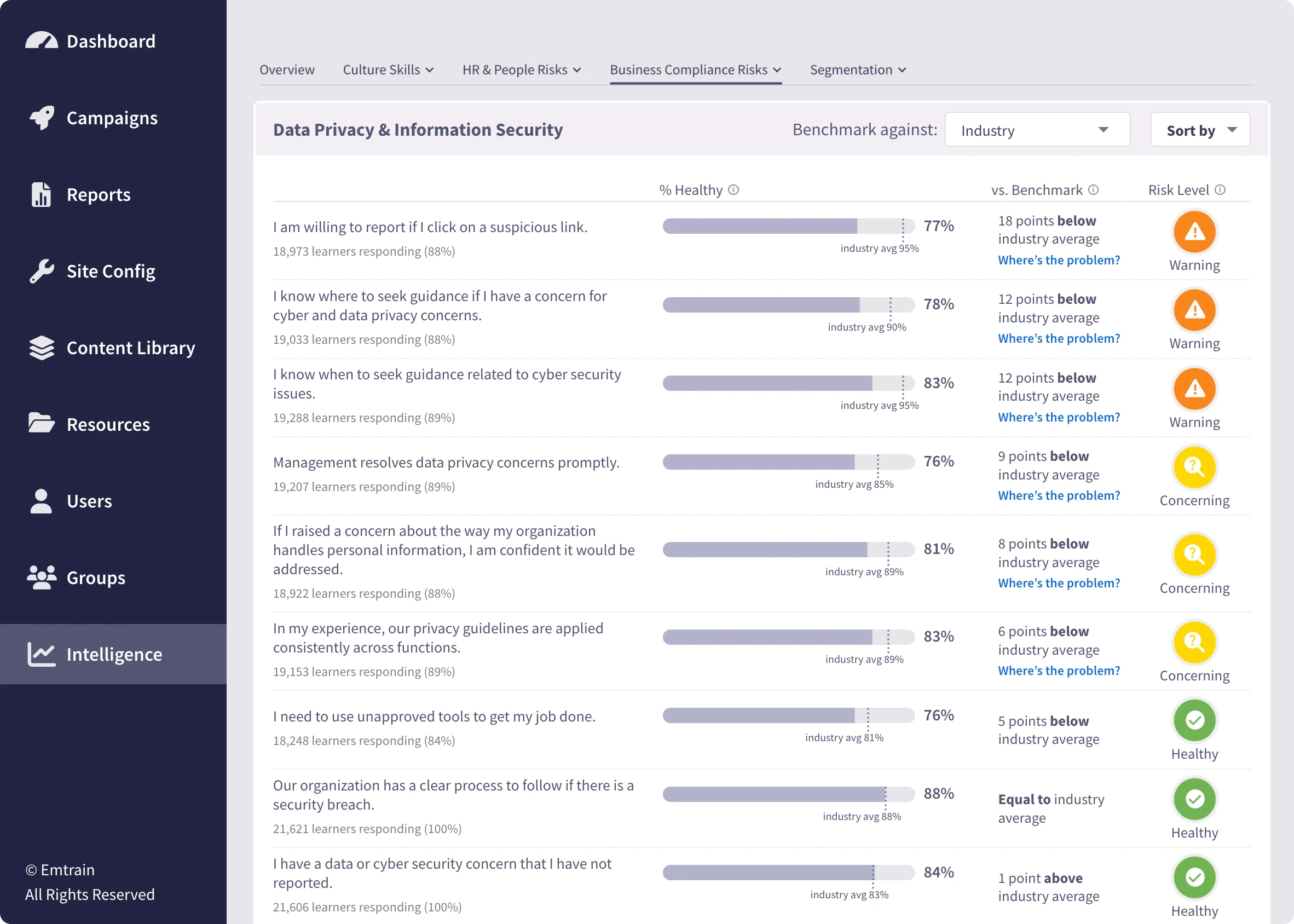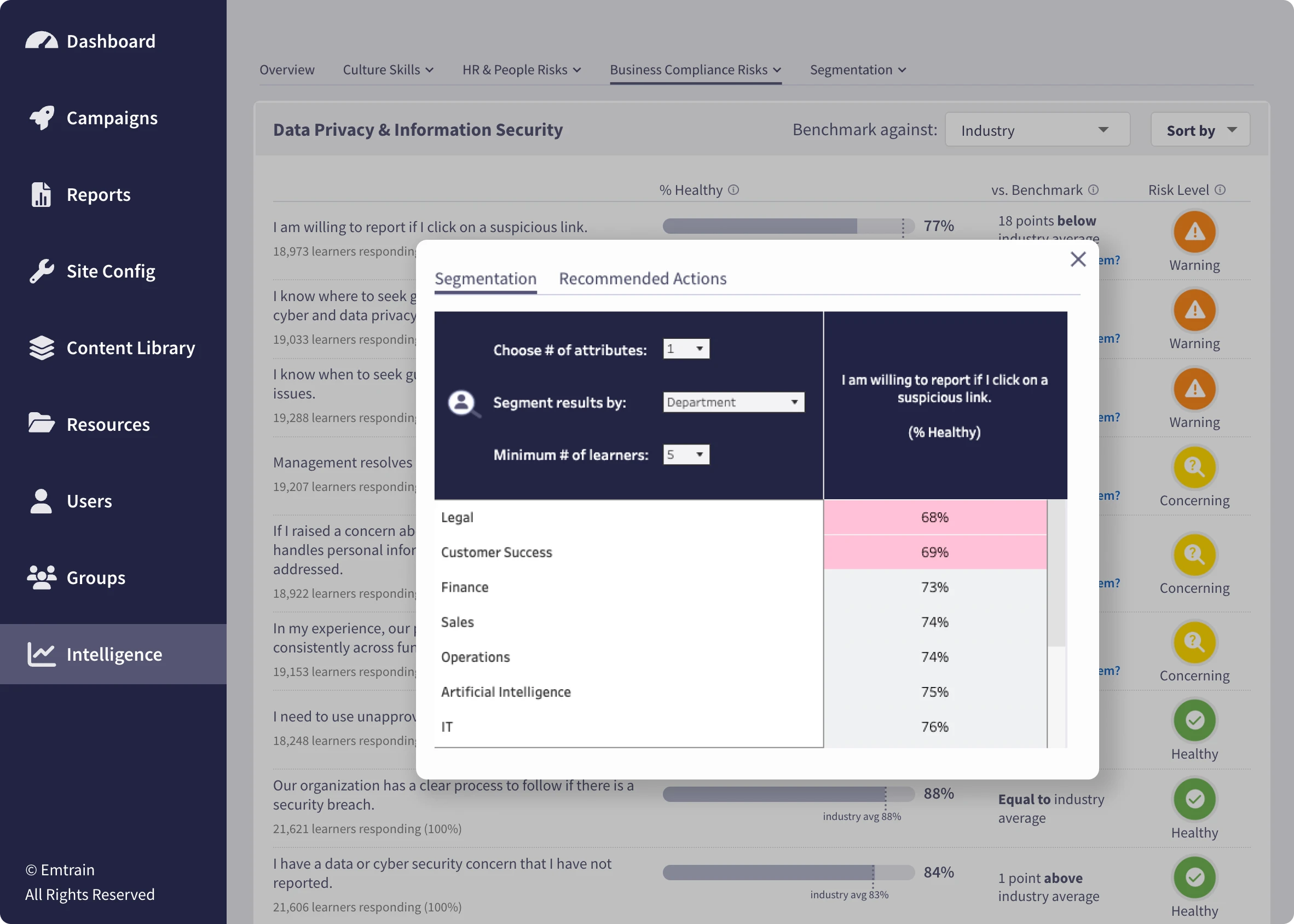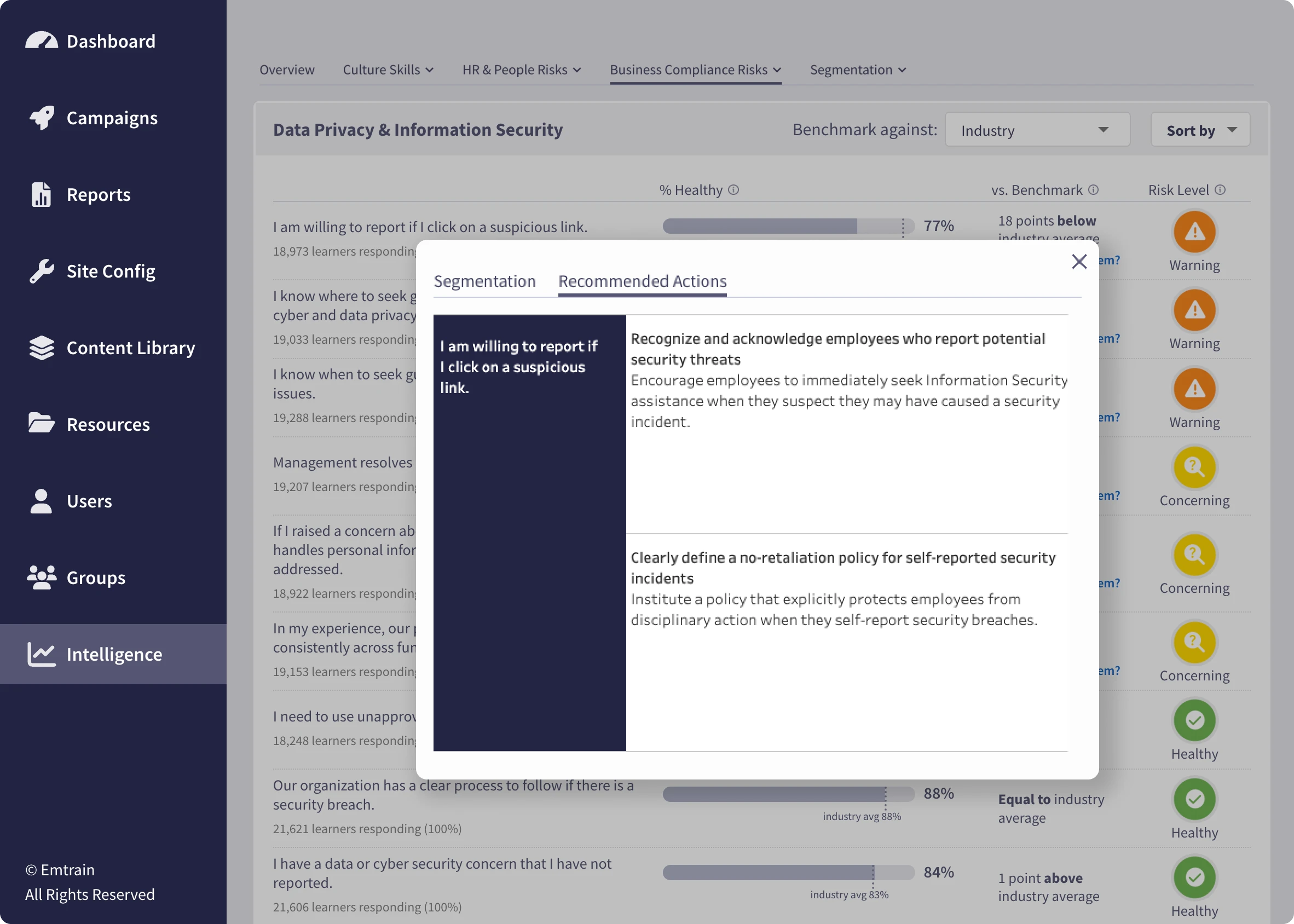Business Compliance risk is easier to manage when you know exactly where to look. Emtrain’s Intelligence platform organizes potential risk into five core areas—each mapped to real compliance obligations and ethical workplace skills, with data sourced from targeted training content.
Ensure employees understand and follow your organization’s ethical standards in daily decision-making. This includes handling gifts, disclosing conflicts of interest, following expense policies, and maintaining professional communication.
Assess awareness and adherence to data protection policies. Measure how well employees safeguard sensitive information, avoid risky tech workarounds, and report potential breaches.
Gauge employees’ ability to recognize and resist bribery risks, even under pressure. Includes gift policies, vendor due diligence, and leadership accountability.
Measure knowledge of fair competition laws and what constitutes inappropriate collaboration or competitive signaling.
Evaluate whether employees feel safe speaking up about misconduct and trust leadership to act without retaliation.
Once we’ve identified potential issues across the five Business Compliance Risk Areas, you can put that knowledge to work. Emtrain’s Business Compliance Risk Intelligence walks you through a clear, repeatable process—helping you measure behaviors, pinpoint compliance gaps, and take targeted action.
Emtrain Intelligence aggregates question-level data from training courses to uncover warning indicators tied to Business Compliance Risks

Dive deeper into specific question scores. See how your team compares to industry benchmarks, broken down by key risk indicators. Our proprietary algorithm reveals how healthy your culture is relative to industry norms — a first-of-its-kind benchmark engine for compliance and culture.

Pinpoint which departments, teams, or tenures are signaling risk — so you know exactly where to act.

In both the HR & People Risks and Business Compliance Risks solutions, questions flagged with a Warning or Concerning risk level will include a Recommended Actions link for that specific question. Recommendations span a range of formats and functions:

The following are sample employee relations risk assessment questions from Emtrain’s training courses. These questions help surface employee sentiment and behavior patterns at scale—enabling organizations to identify early warning signs, detect culture hot spots, and assess knowledge and skill gaps.
The Code of Conduct area covers daily workplace ethics—how employees handle gifts, conflicts of interest, expense reporting, and professional behavior. It focuses on how well your team understands your standards and whether those standards are followed in practice.
Data Privacy & Information Security area assesses whether employees understand how to protect sensitive data and feel equipped to report potential security issues. It surfaces blind spots in both awareness and action, especially around handling personal information or using unapproved tools.
Bribery & Corruption area evaluates your team’s ability to spot and resist pressure to cut corners in pursuit of business goals. It includes questions about gifts, vendor relationships, and whether employees trust leadership to hold the line on compliance.
Why it matters:
Bribery investigations often hinge on overlooked warning signs. Clarity, accountability, and a speak-up culture can prevent issues before they escalate.
This area reflects whether employees feel psychologically safe reporting misconduct. It covers both the perceived risk of retaliation and the confidence that leadership will act on what’s reported.
This area gauges awareness of fair competition laws and whether employees understand what’s considered inappropriate collaboration or signaling in competitive contexts. Questions cover whether:
Employees are familiar with your organization’s fair competition policies.
People know what language to avoid in business communications.
Why it matters:
Antitrust violations can be unintentional—but costly. A clear understanding of what to say (and not say) helps teams steer clear of risk.
Data-driven leadership is an approach that combines careful analysis of employee insights with thoughtful communication to build trust and clarity...
Compliance analytics are rapidly becoming a critical component of effective workplace management. Ensuring adherence to legal and ethical standards is...
Workplace issues rarely emerge suddenly. They usually start small and hidden before growing into larger challenges that impact morale, productivity,...
Traditional surveying methods have long been the foundation for measuring employee sentiment and workplace culture. Annual or periodic surveys aim...
Workplace analytics have quickly become an essential tool for organizations striving to build and sustain a healthy workplace culture. These...
Compliance and privacy are non-negotiable. Especially when it comes to protecting health information. Many organizations ask the question: When should...
AI is changing how we hire, manage, and engage employees—but without the right guardrails, these tools can reinforce bias, create confusion, and damage trust.
HR teams are uniquely positioned to lead the way. This free resource helps you ask the right questions, spot risks, and use AI to support—not replace—human judgment.
At Whirlpool, a leader in home appliances, maintaining a thriving workplace culture is crucial. The company places a strong emphasis on staying ahead of the curve with compliance and ethics training. They’ve found a strategic partner in Emtrain. Whirlpool’s client testimonial highlights two key strengths that Emtrain brings to the table. Up-to-date, consumable content and the seamless integration of survey questions into training modules.
GERRIT J WIERINGA
Senior Counsel, Ethics & Compliance at Whirlpool
On this page, you’ll see a summary of results by risk category (e.g., Code of Conduct, Bribery & Corruption). Each tile highlights:
If you have not deployed the requisite training for a particular Risk Area, it will not populate.
This gives you a quick sense of which risk areas may require attention and where targeted training could make an impact.
Clicking into any risk category (e.g., Harassment & Discrimination) opens a detailed view of the individual Likert-scale questions that power the category’s score. Note: only clients whose package includes this screen will be able to access it!
For each question, you’ll see:
This level of granularity lets you pinpoint exactly what employees are experiencing—and whether it’s a perception issue or something more systemic.
Coming soon: Comparisons to longitudinal scores (i.e. scores last year) and organizations of similar size.
“% Healthy” refers to the percentage of respondents who selected one of the three positive responses (e.g., Slightly Agree, Agree, or Strongly Agree).
For negatively worded questions (e.g., “I’ve heard people make negative stereotypical comments”), healthy responses come from employees who disagree (e.g., Slightly Disagree, Disagree, or Strongly Disagree) with the statement. In these cases, a high “% Healthy” still reflects a positive outcome—indicating that few people are observing or experiencing the negative behavior described.
A high healthy score means most employees feel positively about the topic, indicating a strong and constructive workplace culture. Lower scores may point to dissatisfaction, mistrust, or emerging risk areas that warrant closer review.
Each question is benchmarked against aggregated industry data from similar organizations. Internal scores show you where your teams stand—but benchmarks reveal how your culture stacks up externally. A score might look “fine” in isolation but could be trailing significantly behind peers.
We use the codes defined by the North American Industry Classification System (NAICS) . For tax and documentation purposes, every organization based in the United States is required to register under one of the following industries within the NAICS, which makes it straightforward to use these reported classifications for our benchmarking:
Important note: In cases where we believed an organization’s reported NAICS code significantly diverged from its actual operations or mission, we manually reclassified it to the most appropriate category based on its core activities.
Are all industries equally represented?
No. Some industries have significantly more client representation than others. This disparity stems from various factors, including how well Emtrain’s content resonates with certain industries and the geographic concentration of those industries.
When we have a sufficient number of clients in a given industry (at least 15), we benchmark your results against the industry average. If we don’t have enough data, we instead compare your results to the global average of all clients.
Can I change my reported industry?
Yes! If you do not feel your organization is tagged with the appropriate industry, just let us know at analytics@emtrain.com and we’ll get that updated.
The icon next to each question summarizes whether it presents a cultural or compliance risk:
These flags help you prioritize where to intervene first, especially when managing multiple risk areas.
Use the filters in the left-hand sidebar to refine your results:
Who is considered a new hire?*
New hires are defined as respondents with less than 1 year of tenure at your organization. Since most training is delivered on an annual cycle, these employees will be flagged as “new hires” when they receive their first training shortly after joining. By the time they complete their second training cycle a year later, their responses will no longer fall into this bucket.